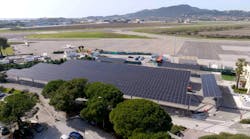As the economy in Asia continues to grow, the need to create better transport infrastructure becomes ever more pressing, particularly in urban centres such as Shanghai, Beijing, and Guangzhou. However, this demand is not only limited to major metropolitan zones but also extends to more remote areas where the production plants that form the backbone of the Asian manufacturing industry are often located.
In the aviation sector ambitious plans are already in place - China has announced its intention to build another 45 airports between now and 2016, whilst expansion is also planned in Hong Kong and other countries across the region. These projects are to be welcomed for Asia’s emergence as a growing player in the global economy and will see the commercial and private aircraft industries flourish which will result in increased pressure for space not only in the air but also on the ground as these new aircraft will need somewhere to sit when they are not in use. Currently there is nowhere near sufficient space to host the volume of equipment expected to start operation within the next eight years.
A larger strategy
However, the reality is that ambition alone will not be enough here. If the sector wants to meet the levels of growth forecast for the next decade, it needs to have a larger strategy in place to help the industry evolve into a more liberal, flexible, and demand-driven environment. It will also need to address some of the concerns that have understandably been raised since the announcement was made to invest so much capital in the sector.
Discussions are currently taking place around some of these issues including the regulation of air space and the addition of new routes on both a domestic and international level. These talks are a positive first step but they represent just one leg of a much longer journey. That said, if the continent can resolve these issues then the opportunity is there to create a model for the aviation sector that could be the envy of the wider world.
Some of the key areas where the industry needs to focus on include:
Environmental and social concerns
- Inevitably, questions have been raised about the environmental impact of building new airports and developing existing ones. With politicians under increasing pressure to demonstrate their ‘green’ credentials, the industry needs to be more proactive in articulating to the world how it is mitigating the environmental impact of all their growth plans. In some cases, expanding an airport can actually help to reduce the social and environmental impact yet how many people know this? If we consider Hong Kong airport as one example, approving the plans to build a third runway would provide additional capacity that would mean aircrafts spent less time idly waiting on the ground until a taxi slot became available, helping to reduce carbon emissions significantly. Furthermore, the extra capacity would also enable the airport to vary the location of the take-off and approach corridor depending on the time of day, reducing the noise pollution that affects adjacent residential areas. With existing constraints, these options are simply not on offer as the airport needs to utilise both runways at all times just to simply service existing demand
An economic case
- To help build new airports across the region, up-front capital investment is unavoidable. However, adopting a commercially-led programme management approach can help ensure that these costs are minimised. Similarly, once the airport is built there are a range of smart solutions that can help to make them financially independent. Today some of the more modern airports outside of Asia can make up to 40% of their profits from non-aeronautical business. One such area would be to maximise the use of the retail space within the airport facilities. This can provide significant capital which can then be used to help maintain and update the infrastructure, and also enables the airport to develop into a recognised employer that delivers wider community benefits
Aviation and the wider growth agenda
- To help assuage concerns around investment in aviation assets, it is vital that the industry can also explain where this development fits in the context of the wider growth agenda throughout Asia. Airports, airline operators and regulators need to work closely together to tell this story and move people away from the false perception that airports are a simple start and end point around which business takes place. The aviation sector itself is a key driver of growth yet many outsiders still under appreciate it’s active contribution to the economic and social standing of a country
Linking airports with additional transport infrastructure
- Air travel is not independent from ‘on-ground’ mobility. The fastest and most convenient journey in the air can be negated if reaching the airport is problematic. Airports today should not exist in isolation within an urban environment. The new airports that are built in Asia need to be easily accessible and better integrated into the wider travel experience, which inevitably starts when travelling to the airport and most likely finishes when the passenger leaves the airport at the other end to go their final destination point. An intelligent transport system that links the various means of travel will drive greater customer satisfaction and in some cases further economic and environmental benefits
With rail and road infrastructure already under construction, the aviation industry needs to follow suit sooner rather than later to keep pace with accelerating growth. Resolving the central issues will be vital in helping to define the overall strategy and to build a realistic timeline that can be followed which outlines how quickly the domestic, pan-Asian, and international air transportation networks that the region now needs, can be built.



